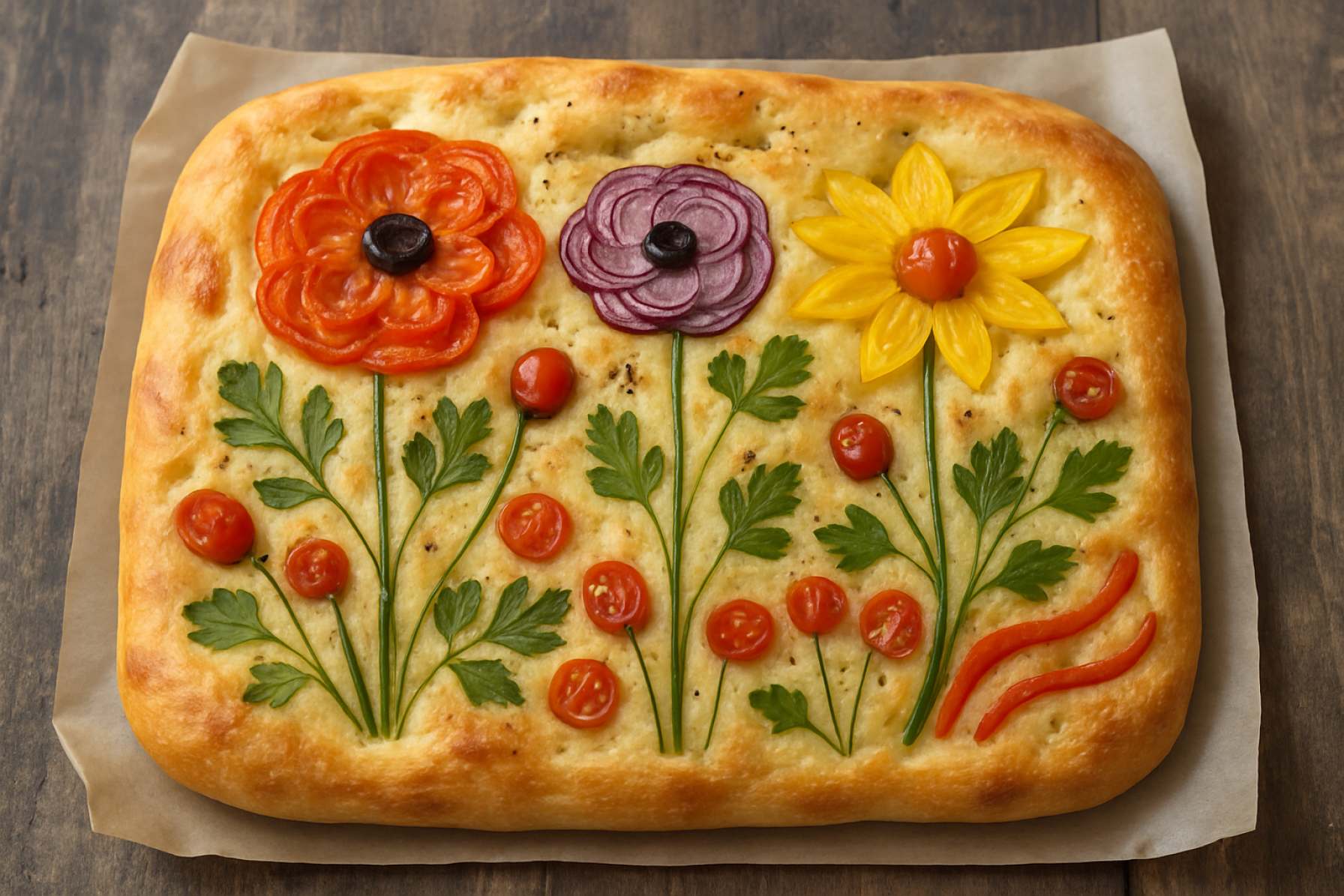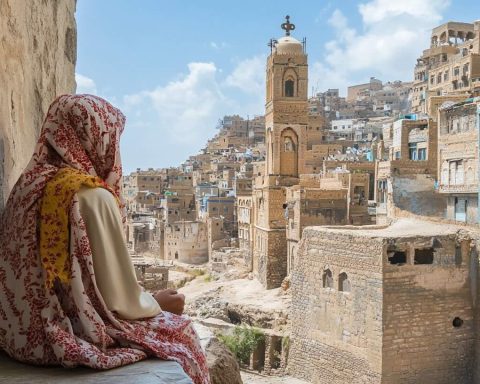Discover the World of Focaccia Art: How Bakers Are Turning Bread Into Edible Masterpieces. Explore Techniques, Trends, and the Future of This Flourishing Culinary Phenomenon. (2025)
- Origins and Evolution of Focaccia Art
- Key Ingredients and Tools for Artistic Focaccia
- Techniques: From Dough Preparation to Decorative Toppings
- Influential Artists and Pioneers in Focaccia Art
- Social Media’s Role in Popularizing Focaccia Art
- Workshops, Classes, and Community Events
- Health, Nutrition, and Ingredient Innovations
- Market Growth and Public Interest: 2020–2024 Trends
- Technology’s Impact: Digital Design and Baking Tools
- Future Outlook: Forecasting Focaccia Art’s Next Wave
- Sources & References
Origins and Evolution of Focaccia Art
Focaccia art, a visually captivating culinary trend, finds its roots in the ancient tradition of focaccia bread-making, which dates back to the Roman Empire. Focaccia itself is a flat oven-baked Italian bread, traditionally seasoned with olive oil, salt, and sometimes herbs. The word “focaccia” is derived from the Latin “panis focacius,” meaning “hearth bread,” referencing its original method of being baked on the hearth. Over centuries, focaccia evolved regionally across Italy, with notable variations such as the Ligurian “focaccia genovese” and the Apulian “focaccia barese,” each with distinct textures and toppings.
The concept of focaccia as an artistic canvas, however, is a relatively recent phenomenon. While traditional focaccia has long been adorned with simple toppings like rosemary, olives, or tomatoes, the deliberate arrangement of vegetables, herbs, and seeds to create intricate, pictorial designs—now known as “focaccia art”—emerged in the late 2010s. This movement was propelled by home bakers and professional chefs alike, who began sharing their creations on social media platforms, inspiring a global audience to experiment with edible artistry.
Focaccia art typically involves pressing colorful ingredients such as bell peppers, cherry tomatoes, red onions, and fresh herbs into the dough before baking, resulting in vibrant, garden-like scenes or abstract patterns. The trend gained significant momentum during the COVID-19 pandemic, as people sought creative outlets and comfort in home baking. The accessibility of focaccia dough and the endless possibilities for decoration made it an ideal medium for both novice and experienced bakers.
While focaccia art is not officially regulated or overseen by any single organization, it is celebrated by culinary institutions and baking communities worldwide. For example, the Accademia Italiana della Cucina, an Italian cultural institution dedicated to preserving and promoting traditional Italian cuisine, recognizes focaccia as a staple of Italian gastronomy. The Slow Food movement, which advocates for the preservation of regional food traditions, also highlights focaccia as an example of Italy’s rich baking heritage.
By 2025, focaccia art continues to evolve, with bakers experimenting with new techniques, ingredients, and themes. Workshops, online tutorials, and social media challenges have further popularized the practice, transforming focaccia from a humble bread into a celebrated form of edible art that bridges tradition and innovation.
Key Ingredients and Tools for Artistic Focaccia
Focaccia art, a creative evolution of the traditional Italian flatbread, transforms the baking process into a canvas for edible expression. The foundation of any artistic focaccia lies in its dough, which typically consists of high-quality wheat flour, water, extra virgin olive oil, salt, and yeast. The choice of flour is crucial; many bakers prefer bread flour for its higher protein content, which yields a chewy, airy crumb ideal for supporting decorative toppings. Extra virgin olive oil not only enriches the dough’s flavor but also imparts a golden, crisp crust, a hallmark of authentic focaccia (Olio Officina).
The toppings are where focaccia art truly comes to life. Fresh vegetables such as bell peppers, cherry tomatoes, red onions, and olives are commonly used for their vibrant colors and ability to retain shape during baking. Herbs like rosemary, thyme, and basil add aromatic complexity and visual appeal. Some bakers incorporate edible flowers, seeds, and even cheeses to enhance both aesthetics and taste. The key is to select ingredients that withstand oven temperatures without losing their color or texture, ensuring the final design remains vivid and appetizing.
Essential tools for creating focaccia art include a sturdy baking sheet or pan, which provides even heat distribution and supports the dough’s structure. Parchment paper is often used to prevent sticking and facilitate easy removal. For intricate designs, bakers may use small, sharp knives or kitchen shears to shape vegetables, and tweezers or toothpicks to position delicate elements precisely. A pastry brush is helpful for applying olive oil to both the dough and toppings, promoting even browning and a glossy finish.
Temperature control is another critical factor. Most recipes recommend proofing the dough at room temperature to develop flavor and texture, followed by baking in a preheated oven at around 220°C (428°F). This ensures the bread rises properly and the toppings cook evenly without burning. Some bakers use a spray bottle to mist the dough before baking, which can enhance crust development and help toppings adhere.
In summary, the artistry of focaccia depends on a harmonious blend of quality ingredients and specialized tools. By thoughtfully selecting each component and employing precise techniques, bakers can create visually stunning and delicious breads that celebrate both tradition and innovation in Italian baking (Accademia Italiana della Cucina).
Techniques: From Dough Preparation to Decorative Toppings
Focaccia art is a creative culinary practice that transforms the traditional Italian flatbread into an edible canvas, using vegetables, herbs, and other toppings to craft intricate designs. The process begins with the preparation of the dough, which forms the foundation for both texture and visual appeal. Classic focaccia dough is made from high-protein wheat flour, water, olive oil, salt, and yeast. The dough is typically mixed until smooth and elastic, then allowed to rise slowly, often overnight, to develop flavor and a light, airy crumb. The use of extra virgin olive oil, both in the dough and generously brushed on top, is essential for achieving the characteristic golden crust and moist interior, as recommended by organizations such as the Olio Officina, which promotes olive oil culture and quality standards.
Once the dough has risen, it is gently stretched and pressed into a well-oiled baking tray. Care is taken not to deflate the dough excessively, preserving the air bubbles that contribute to focaccia’s signature texture. Before baking, the surface is dimpled with fingertips, creating small wells that help hold olive oil and toppings in place. This step is crucial for both the bread’s structure and the eventual placement of decorative elements.
The artistry of focaccia art lies in the arrangement of toppings. Bakers use a variety of colorful vegetables—such as bell peppers, cherry tomatoes, red onions, and olives—along with fresh herbs like rosemary, thyme, and basil. These ingredients are sliced, shaped, and positioned to create floral motifs, landscapes, or abstract patterns. The Accademia Italiana della Cucina, an institution dedicated to preserving Italian culinary traditions, highlights the importance of ingredient quality and regional authenticity in focaccia making. Edible seeds, cheeses, and even natural food colorings can be incorporated for additional detail and vibrancy.
Timing and temperature are critical during baking. Focaccia is typically baked at a high temperature (220–230°C) to ensure a crisp crust and well-cooked toppings. Bakers must balance the need for a golden, airy crumb with the preservation of the decorative elements’ color and texture. Some practitioners partially bake the bread before adding delicate toppings, then finish baking to prevent overcooking. The result is a visually stunning and flavorful bread that celebrates both Italian tradition and contemporary creativity.
Influential Artists and Pioneers in Focaccia Art
Focaccia art, a vibrant intersection of culinary craft and visual creativity, has seen a surge in popularity in recent years, thanks to the innovative efforts of several influential artists and pioneers. These individuals have transformed the humble Italian flatbread into a canvas for edible masterpieces, inspiring a global community of home bakers and professional chefs alike.
One of the most widely recognized pioneers in focaccia art is Teri Culletto, often referred to as the “Vineyard Baker.” Based in Massachusetts, Culletto is credited with popularizing the trend of decorating focaccia with intricate designs made from vegetables, herbs, and edible flowers. Her creations, which often depict landscapes, floral arrangements, and abstract patterns, have been widely shared on social media platforms, sparking a worldwide movement. Culletto’s work emphasizes the use of seasonal, locally sourced ingredients, and she frequently shares tutorials and workshops to encourage others to explore their own creativity through bread making.
Another notable figure is Hannah Page, whose detailed and whimsical focaccia designs have garnered significant attention. Page’s approach often involves storytelling through bread, using the surface of focaccia to illustrate scenes from nature or daily life. Her work demonstrates the versatility of focaccia as an artistic medium and has inspired many to experiment with their own designs.
The influence of these artists has extended beyond individual kitchens to culinary institutions and educational programs. Organizations such as the Slow Food movement, which advocates for traditional and sustainable food practices, have highlighted focaccia art as a way to celebrate regional ingredients and artisanal techniques. By incorporating local produce and traditional baking methods, focaccia artists contribute to the preservation and evolution of food culture.
In addition, professional bakers and chefs in Italy and abroad have embraced focaccia art, incorporating it into bakery offerings and culinary workshops. The Federazione Italiana Cuochi (Italian Chefs Federation), a leading organization representing Italian culinary professionals, has recognized the artistic and cultural value of focaccia art, featuring it in events and educational materials.
Through the creativity and dedication of these pioneers, focaccia art has evolved from a niche trend to a celebrated form of edible expression, inspiring a new generation of bakers to blend artistry with tradition.
Social Media’s Role in Popularizing Focaccia Art
Social media has played a pivotal role in the popularization of focaccia art, transforming a traditional Italian bread into a global canvas for creativity. The visually striking nature of focaccia art—where bakers use vegetables, herbs, and seeds to create intricate designs atop the dough—makes it particularly well-suited for platforms that prioritize visual content. Instagram, in particular, has become a hub for sharing and discovering focaccia art, with hashtags like #focacciaart and #breadart amassing thousands of posts from amateur bakers and professional chefs alike. The platform’s algorithm, which favors eye-catching and unique visuals, has helped propel these edible artworks into viral trends, inspiring home bakers worldwide to experiment with their own designs.
The COVID-19 pandemic further accelerated this trend, as people sought creative outlets and comfort in home baking. Social media challenges and tutorials proliferated, with users sharing step-by-step guides and time-lapse videos of their focaccia art creations. This communal sharing fostered a sense of connection and inspiration, even during periods of isolation. Notably, the interactive nature of platforms like TikTok and Instagram Reels allowed for rapid dissemination of techniques and ideas, making focaccia art accessible to a broad audience regardless of prior baking experience.
Professional organizations and culinary institutions have also recognized the impact of social media on the focaccia art movement. For example, the World Federation of Professional Bread Bakers (WFPB), an international body dedicated to promoting bread culture and education, has highlighted the role of digital platforms in democratizing bread artistry and encouraging innovation. Similarly, culinary schools and baking associations have incorporated focaccia art into their curricula and online workshops, often sharing their students’ creations on official social media channels to reach wider audiences.
The viral nature of focaccia art on social media has also influenced commercial bakeries and food brands, many of which now feature artistic focaccia in their product lines or marketing campaigns. This cross-pollination between home bakers, professionals, and brands underscores the power of social media to shape food trends and foster a global community centered around creativity and shared passion. As social media continues to evolve, it is likely that focaccia art will remain a vibrant and dynamic expression of edible artistry, inspiring new generations of bakers in 2025 and beyond.
Workshops, Classes, and Community Events
Focaccia art, the creative practice of decorating focaccia bread with vibrant arrangements of vegetables, herbs, and edible flowers, has inspired a growing number of workshops, classes, and community events worldwide. These gatherings offer both novice and experienced bakers the opportunity to learn the techniques behind focaccia art, from dough preparation to the intricate placement of toppings that transform bread into edible canvases.
Workshops are often hosted by artisan bakeries, culinary schools, and community centers, providing hands-on instruction in a collaborative environment. Participants typically explore the fundamentals of focaccia dough—hydration, fermentation, and shaping—before delving into the artistic aspects. Instructors guide attendees through the selection and preparation of colorful ingredients such as cherry tomatoes, bell peppers, olives, and fresh herbs, emphasizing both aesthetics and flavor balance. Many classes also highlight the importance of using seasonal and locally sourced produce, aligning with broader trends in sustainable and mindful cooking.
Community events centered on focaccia art have become popular as interactive experiences for families, friends, and food enthusiasts. These events often feature group baking sessions, friendly competitions, and public exhibitions of finished breads. Such gatherings foster creativity, encourage social connection, and celebrate the intersection of food and art. In some regions, local food festivals and farmers’ markets have incorporated focaccia art demonstrations, inviting professional bakers and home cooks alike to showcase their skills and inspire others.
Culinary organizations and educational institutions have also recognized the value of focaccia art as a teaching tool. By integrating focaccia art into their curricula, they promote not only baking proficiency but also artistic expression and cultural appreciation. For example, some culinary schools offer specialized courses that explore the history of focaccia, regional variations, and contemporary trends in bread decoration. These programs often culminate in collaborative projects or public displays, further engaging the community and elevating the profile of focaccia art.
The rise of virtual workshops has expanded access to focaccia art instruction, enabling participants from around the world to join live classes or follow recorded tutorials. This digital shift has been supported by organizations such as King Arthur Baking Company, which offers online resources and interactive sessions for bread enthusiasts. Through these diverse educational and community initiatives, focaccia art continues to flourish as both a culinary craft and a form of creative expression.
Health, Nutrition, and Ingredient Innovations
Focaccia art, the creative practice of decorating focaccia bread with vibrant arrangements of vegetables, herbs, and seeds, has evolved beyond its aesthetic appeal to embrace health, nutrition, and ingredient innovation. Traditionally, focaccia is made from a simple dough of flour, water, yeast, olive oil, and salt. However, the growing interest in health-conscious eating and plant-based diets has inspired bakers and home cooks to experiment with nutrient-dense ingredients and alternative flours, making focaccia art both visually stunning and nutritionally enhanced.
One of the most significant health innovations in focaccia art is the incorporation of whole grain and ancient grain flours, such as spelt, rye, and einkorn. These flours offer higher fiber content, essential minerals, and a broader spectrum of micronutrients compared to refined wheat flour. The Whole Grains Council, a non-profit organization dedicated to increasing whole grain consumption, highlights the benefits of whole grains in supporting digestive health and reducing the risk of chronic diseases.
Toppings play a central role in both the artistic and nutritional aspects of focaccia art. Fresh vegetables like bell peppers, tomatoes, red onions, and leafy greens are commonly used to create intricate designs. These ingredients not only add color and texture but also contribute vitamins, antioxidants, and dietary fiber. Herbs such as rosemary, thyme, and basil provide flavor while offering anti-inflammatory and antimicrobial properties, as recognized by the Herb Society of America, an organization dedicated to promoting the knowledge and use of herbs.
Ingredient innovation also extends to the use of seeds—such as chia, flax, and sunflower—which are often sprinkled atop focaccia art for added crunch and nutritional value. Seeds are rich in omega-3 fatty acids, protein, and minerals, supporting heart health and overall wellness. The U.S. Food and Drug Administration (FDA) recognizes the role of such nutrient-dense foods in a balanced diet.
For those with dietary restrictions, gluten-free focaccia art is gaining popularity. Bakers are experimenting with gluten-free flour blends made from rice, chickpea, or almond flour, ensuring that the creative and healthful aspects of focaccia art are accessible to a wider audience. This aligns with broader trends in food innovation, where inclusivity and nutrition are prioritized alongside culinary creativity.
Market Growth and Public Interest: 2020–2024 Trends
Between 2020 and 2024, focaccia art—a creative culinary trend where bakers transform focaccia bread into visually stunning canvases using vegetables, herbs, and edible flowers—experienced remarkable growth in both market presence and public interest. This surge was catalyzed by the global COVID-19 pandemic, which saw a significant increase in home baking as people sought comfort and creative outlets during lockdowns. Social media platforms, particularly Instagram and Pinterest, played a pivotal role in popularizing focaccia art, with thousands of users sharing their intricate bread designs and inspiring a global audience to experiment with this edible art form.
The trend’s momentum was further fueled by the accessibility of focaccia recipes and the minimal equipment required, making it an appealing entry point for novice bakers. The visual appeal of focaccia art, often featuring vibrant arrangements of tomatoes, peppers, onions, and fresh herbs, resonated with consumers seeking both aesthetic and gastronomic satisfaction. This led to a proliferation of online tutorials, virtual baking classes, and dedicated hashtags, which amplified the trend’s reach and fostered a sense of community among enthusiasts.
Artisan bakeries and specialty food retailers responded to the growing demand by offering focaccia art workshops and incorporating decorative focaccia into their product lines. Culinary organizations, such as the International Culinary Center, began to acknowledge focaccia art in their curricula, reflecting its integration into contemporary baking culture. Additionally, the Slow Food movement, which champions traditional and artisanal food practices, highlighted focaccia art as an example of how heritage recipes can be reimagined for modern audiences while preserving their cultural significance.
From a market perspective, the period saw a notable increase in sales of bread-making ingredients, particularly high-quality flours, olive oils, and specialty toppings, as reported by industry suppliers. The trend also contributed to the growth of home baking equipment sales, such as baking trays and decorative tools. Food festivals and culinary competitions began to feature focaccia art categories, further legitimizing its status within the broader food and beverage sector.
By 2024, focaccia art had evolved from a niche hobby to a mainstream phenomenon, embraced by home bakers, professional chefs, and food artists alike. Its continued popularity underscores the enduring appeal of creative, hands-on culinary experiences and the power of social media to shape food trends on a global scale.
Technology’s Impact: Digital Design and Baking Tools
The intersection of technology and culinary creativity has significantly influenced the evolution of focaccia art, a practice where bakers transform traditional Italian flatbread into visually stunning, edible canvases. In 2025, digital design tools and advanced baking equipment are reshaping how both amateur and professional bakers approach this craft, enabling greater precision, innovation, and accessibility.
Digital design software, such as graphic illustration programs and tablet-based sketching apps, allows bakers to pre-visualize their focaccia art before touching any dough. By mapping out intricate floral patterns, landscapes, or abstract motifs digitally, artists can experiment with color palettes and ingredient placement, reducing trial and error in the kitchen. This pre-planning stage is especially valuable for large-scale projects or commercial bakeries seeking consistency across multiple loaves.
In addition to design software, 3D printing technology is making inroads into the world of focaccia art. Food-safe 3D printers can create custom stencils, molds, and even edible decorations from dough or vegetable purees. These tools enable bakers to achieve complex shapes and textures that would be difficult to replicate by hand, expanding the creative possibilities of focaccia art. For example, intricate leaf patterns or geometric designs can be produced with remarkable uniformity, elevating the visual impact of each loaf.
Modern ovens equipped with smart technology further enhance the baking process. Features such as precise temperature control, humidity regulation, and programmable baking cycles ensure that the bread’s texture and color are optimized for artistic presentation. Some ovens now offer app connectivity, allowing bakers to monitor and adjust settings remotely, which is particularly useful for commercial kitchens or educational settings where multiple batches are prepared simultaneously. Companies like Electrolux and Bosch have integrated such smart features into their latest models, supporting both home and professional bakers.
Social media platforms and online communities also play a pivotal role in the dissemination and evolution of focaccia art. High-resolution photography, video tutorials, and live-streamed baking sessions enable artists to share techniques, inspire others, and receive real-time feedback. Organizations such as the International Culinary Center (now part of the Institute of Culinary Education) offer online courses and resources, further democratizing access to advanced baking knowledge and digital design skills.
In summary, the integration of digital design tools, 3D printing, smart baking equipment, and online educational resources is transforming focaccia art in 2025. These technological advancements empower bakers to push creative boundaries, achieve greater consistency, and connect with a global community of culinary artists.
Future Outlook: Forecasting Focaccia Art’s Next Wave
As the culinary world continues to embrace creativity and visual storytelling, the future of focaccia art appears especially promising. In 2025, several trends and innovations are poised to shape the next wave of this edible art form, blending tradition with modern sensibilities and technology.
One significant driver is the growing global interest in artisanal breadmaking, fueled by the home baking surge witnessed during recent years. Focaccia art, with its accessible techniques and visually stunning results, is increasingly featured in workshops, online tutorials, and social media challenges. This democratization of bread artistry is expected to continue, with more home bakers and professionals experimenting with new ingredients, colors, and themes. The use of natural colorants—such as beetroot, turmeric, and spirulina—will likely expand, allowing for even more vibrant and health-conscious designs.
Technological advancements are also set to influence focaccia art. The integration of digital tools, such as edible ink printers and laser cutters, may enable bakers to achieve unprecedented precision and complexity in their designs. These innovations could make focaccia art more accessible to those with limited artistic skills, while also inspiring seasoned bakers to push creative boundaries. Additionally, the rise of augmented reality (AR) applications in the culinary sector may allow users to visualize and plan their focaccia art before baking, further enhancing the creative process.
Sustainability and local sourcing are expected to play a larger role in the evolution of focaccia art. Bakers are increasingly turning to seasonal, locally grown produce for their edible decorations, aligning with broader movements toward environmental responsibility and food transparency. This trend is supported by organizations such as Slow Food, which advocates for the preservation of regional food traditions and biodiversity. By highlighting local ingredients, focaccia artists can tell unique stories about their communities and contribute to a more sustainable food system.
Finally, the educational and therapeutic potential of focaccia art is gaining recognition. Culinary schools and community organizations are incorporating bread art into their curricula and wellness programs, citing its benefits for mindfulness, creativity, and social connection. As these initiatives expand, focaccia art is likely to become an even more integral part of both culinary education and community engagement.
In summary, the future of focaccia art in 2025 will be shaped by a blend of technological innovation, sustainability, and a continued passion for creative expression. As bakers around the world experiment with new tools, ingredients, and ideas, focaccia art is set to remain a vibrant and evolving canvas for edible creativity.
Sources & References
- Accademia Italiana della Cucina
- World Federation of Professional Bread Bakers
- King Arthur Baking Company
- Whole Grains Council
- Herb Society of America
- International Culinary Center
- Bosch









